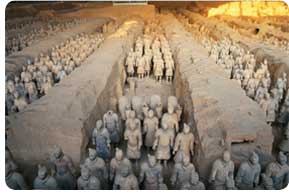 BRIEF INTRODUCTION TO XI’AN BRIEF INTRODUCTION TO XI’AN
Xi’an is located in the central part of China and lies near the River Wei in the Guanzhong Plain on the Middle reaches of the Yellow River. It is surrounded to the south by the Qinling mountain range, to the north by the River Wei, while the Huashan mountains stand at its east, and the highest peak of the Taibai mountains at its west. Set at 424 meters above sea level the region enjoys a mild climate with four distinctive seasons. The relief of the area consists of mountains, rivers, plains and plateaus. The city of Xi’an is composed of 9 districts and 4 outlying counties covering a total area of 9983 square kilometres with a population of about 7.2 million, of which 5.1 million live in the urban zone. Xi’an was called Chang’an in ancient times. Universally reputed as a cultural and historical city, she is considered alongside with Cairo, Rome and Athens to be one of the “four ancient capitals” of the world.
Xi’an is one of the cradles of Chinese civilization and a birthplace of humanity. In this region was discovered the earliest pithecanthropine hominid fossil (with both human and simian characteristics) in northern Asia - Lantian man - who lived around 11 million years ago. Our 6000 year old ancestors, the matriarchal clan community of the Banpo lived on farming and hunting in this area during the Neolithic age. Beginning in the 11th century BC with the Western Zhou dynasty, a society based on slavery, up to the apogee of the imperial period under the Tang dynasty, Xi’an was for 1100 years the capital of 13 dynasties under the Zhou, the Qin, the Han, and the Tang. Eastern terminus of the old Silk Road and first metropolis in the world with a population exceeding 1 million, Xi’an became the respected symbol of oriental civilization and thus contributed greatly to the development of human civilization. Its prominent place in history has bequeathed Xi’an with a great number of remains. There are 2944 registered sites inside the city and in its surrounding area, of which 34 are national monuments. Among these, the Tomb of Qin Shihuang which is inscribed on UNESCO’s World Heritage List and whose terracotta warriors and horses have been called “the Eighth Wonder in the World”. Xi’an has witnessed many different periods in the development of human society. Each has left its traces and together these create a kind of “museum of Chinese history”. The prosperous periods, especially during the Zhou, the Qin, the Han and the Tang dynasties, have left a large number of monuments in Xi’an such as the ruins of the Zhou dynasty town of Fenhao, the remains of the Epang palaces built under the Qin, the city wall of Chang’an erected under the Han dynasty and the site of the Daming palaces dating from the Tang period, to name only but a few. Moreover, the “emperor’s bathroom” - the Huaqing Hot Spring; the “stone bookstore of China” - the Forest of Stone tablets; the thousand year old Buddhist tower - the Big Wild Goose Pagoda; the first modernist national museum – the National Museum of Shaanxi History; the largest and best protected city wall - Xi’an’s City Wall dating from the Ming Dynasty, and many other sites, reveal the splendid history and culture of the city. All these elements give Xi’an an atmosphere and energy which attract visitors from all over the world. The cultural history of Xi’an is rich and varied. The city played a role in the birth of Taoism and Confucianism, but also in the spread of Buddhism. She saw the creation of masterpieces of Chinese classical literature such as “The Book of Odes”, Han style folk songs and ballads, and the famous Tong poem. Her School of Painting and Drawing, the so called Chan’an School, influenced this art in China during more than 400 years and the city welcomed a great many famous Chinese discoverers in particular in the technical field. All these achievements contributed to the progress of civilization in China and throughout the world.
Today Xi’an enjoys international recognition for its culture and history and is a famous tourist attraction. Main city on the upper and middle reaches of the Yellow River and bridge of the Eurasian continent, the city is open and modern combining in a unique manner culture, education, scientific, technological, commercial, educational and tourism development. Xi’an has the third largest number of colleges and universities in China, and a well established scientific and high-tech industry, which benefits from the city’s position as a well-connected transport hub for the whole country.
Its renowned culinary art with, among other, the delicious Jiaozi (dumpling) banquets and the typical Yangroupao and niuroupao (shredded pancake in mutton and beef soup); the local colorful Qin opera and the ancient Chang’an style music, are attracting increasing world-wide interest.
Xi’an, a characteristic blend of ancient and modern culture, is getting ready to welcome the ICOMOS delegations from all over the world. |



